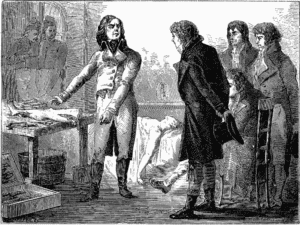Howard Fischer
Uppsala, Sweden
 |
|
Larrey provokes contractions on a recently amputated limb. Illustration from Les merveilles de la science, 1867-1891, Tome 1, by Louis Figuier. Paris: Furne, Jouvet. Via Wikimedia. Public domain. |
Dominique Jean Larrey (1766-1842), the orphaned son of a shoemaker, was raised by an uncle who was a surgeon and became a physician himself by the age of twenty-one. He gave medical assistance to those who stormed the Bastille and supported the French Revolution. In the first war waged against republican France, Larrey organized field hospitals, an ambulance corps, and a system to triage the wounded based entirely on the severity of the injury rather than rank, title, or nationality.
Before Larrey’s “flying ambulances,” military ambulances stayed well behind the front lines and collected the wounded after a long delay, often as long as twenty-four hours. Few soldiers survived so many hours of exposure without food, water, or basic first aid. These pre-Larrey ambulances were enormous affairs, holding 134 people (including thirty-one surgeons and thirty-one nurses) and pulled by forty horses. Larrey devised two types of ambulances: a light one pulled by two horses that could hold two to four patients, and a heavier one pulled by four horses that could hold four to eight patients.1 The ambulance and its crew rapidly collected the injured and stabilized them en route to areas where surgery could be performed. Knowing that rapid care was available boosted the morale of French troops.2
Larrey stopped the practice of putting grease or ointments on wounds and instead washed them with Labarraque solution, a 4% solution of sodium hypochlorite in water3 also called “eau de javel“. For comparison, household bleach is a 5% hypochlorite solution. He insisted on vigorous debridement of devitalized tissue in gunshot injuries,4 washed his hands before operating (not a universal practice at that time), and wore a mask.5
He was an innovator in the field of military surgery: the first to incise the pericardium6 and the first to perform a successful amputation of a leg at the hip.7 He classified aneurysms and noted the relationship between syphilis and thoracic aortic aneurysms.8 He wrote the first report on mass cold injury (frostbite) during the 1812-1813 invasion of Russia and demonstrated the value of rewarming frozen tissue.9 He also invented the curved suturing needle.10 Larrey served the French army for twenty-eight years and was present at fifty-five battles in twenty-five campaigns and several sieges.11 Napoleon said of him, “C’est l’homme le plus vertueux que j’aie connu,”12 that is, “He is the most virtuous man I know.” He was described as “rugged and forthright” and respected common sense. His Memoire de Chirurgie Militaire in five volumes is considered a “surgical classic.”13 Wiese writes, “No one in the entire army, not even Napoleon himself, commanded more love or respect than Larrey.”14 His remains are in Les Invalides in Paris, near the tomb of Napoleon.
References
- Robert Wiese. “Larrey, Napoleon’s Chief Surgeon,” Ann Med Hist, 1(4), 1929.
- Jose Ortiz. “The revolutionary flying ambulance of Napoleon’s surgeon,” US Army Medical Department Journal, Oct/Dec 1998.
- A.R. Munro. “Baron Larrey- Surgeon General to Napoleon’s army,” Can MAJ, 48, 1943.
- Wiese. “Chief Surgeon.”
- J.C. Robb. “Baron Larrey (1766 – 1842) – Napoleon’s chief surgeon and his times,” Ulster Med J, 21(2), 1952.
- Munro. “Baron Larrey.”
- Ortiz. “Revolutionary.”
- Wiese. “Chief Surgeon.”
- Charles Hanford, Pauline Buxton, Katie Russell, et. al. “Frostbite- a pratical approach to hospital management,” Extreme Physiology and Medicine, 3, 2014.
- Fielding Garrison. “The nineteenth-century -The revolutionary and Napoleonic wars,” In Notes on the History of Military Medicine, New York:Georg Olms Verlag, 1970.
- Françoise Deherly. “Dominique Larrey, Chirurgien Militaire,” LeBlog Gallica, 2012.
- James Dible. “Dominique Jean Larrey, a surgeon of the revolution the Consulat, and empire,” Med Hist, 3(2), 1959.
- Dible. “Dominique Jean Larrey.”
- Wiese. “Chief Surgeon.”
HOWARD FISCHER, MD was a professor of pediatrics at Wayne State University School of Medicine, Detroit, Michigan.

Leave a Reply